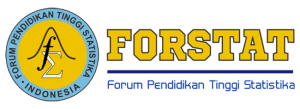Faktor-Faktor yang Memengaruhi Komplikasi Persalinan Wanita Usia Subur di Indonesia Menggunakan Data SDKI 2012 (Aplikasi Analisis Regresi Logistik Biner Multilevel)
DOI:
https://doi.org/10.34123/jurnalasks.v8i2.53Keywords:
the incidence of birth complications, Indonesia Demographic and Health Survey 2012 (SDKI-2012) and Regression of Logistic Biner Multilevel AnalysisAbstract
Maternal Mortality Rate (MMR) is still a crucial problem in Indonesia considering the incidence rate is still high enough that is about 359 per 100,000 births. The biggest cause of MMR in Indonesia is due to the high incidence of birth complications. This papers aims to determine the factors that affect the incidence of birth complications in women of childbearing age in Indonesia by using regression of logistic biner multilevel analysis. The data used are sourced from Indonesia Demographic and Health Survey 2012 (SDKI-2012). Based on the results of data processing, it is known that variables of parity, pregnancy complications, history of previous complications and ratio of health centers per 100,000 population are significantly affect the incidence of birth complications in women of childbearing age in Indonesia
Downloads
References
Agresti, Alan. (2002). Categorical Data Analysis (2nd Edition). New Jersey : John Wiley and Sons.
Armagustini, Y. (2010). Determinan Kejadian Komplikasi Persalinan di Indonesia [Tesis]. Depok : Universitas Indonesia.
Bank Dunia. (2008). Berinvestasi dalam Sektor Kesehatan Indonesia: Tantangan dan Peluang untuk Pengeluaran Publik di Masa Depan. Jakarta : Bank Dunia.
Bobak, I.M., et al. (2004). Keperawatan Maternitas. Jakarta: EGC
Cavazos-Rehg PA, et all (2015). Maternal Age and Risk of Labor and Delivery Complications. Diakses tanggal 29 maret 2016 melalui https://www.ncbi.nlm.nih.gov/pubmed/25366100
Chakraborty, N., et al. (2006). Delivery complications and healthcare-seeking behaviour: the Bangladesh Demographic Health Survey, 1999–2000. Health and Social Care in the Community Journal. Diakses tanggal 5 Mei 2016 melalui https://www.ncbi.nlm.nih.gov/pubmed/17444989
Departemen Kesehatan RI. (1997). Deteksi Dini Penatalaksanaan Kehamilan Risiko Tinggi. Jakarta: Pendidikan dan Latihan Pegawai Departemen Kesehatan Republik Indonesia.
Departemen Kesehatan. (2001). Rencana Strategis Nasional Making Pregnancy Safer (MPS) di Indonesia 2001-2010. Jakarta : Depkes RI.
Djaja, Sarimawar. dan Suwandono, Agus., (2000). The Determinants of Maternal Morbidity in Indonesia. Regional Health Forum WHO South-East Asia Region Volume 4, WHO. Diakses tanggal 27 Juni 2016 melalui http://apps.who.int/iris/handle/10665/205788
Djalal, Nachrowi dan Usman, Hardius. (2002). Penggunaan Teknik Ekonometri. Jakarta: PT Raja Grafindo Persada.
Goldstein, Harvey. (1995). Multilevel Statistical Models. London: Edward Arnold.
Goldstein, Harvey. (2010). Multilevel Statistical Models 4th Edition. London: John Wiley & Sons.
Gujarati, Damodar. (2002). Basic Econometrics 4th Edition. New York: McGraw-Hill.
Hay, Cameron. (2010). Dying mothers: Maternal mortality in rural Indonesia. Medical Anthropology, Vol.18,pp. 243-279.
Hosmer, D.W dan Lemeshow, S. (2000). Applied Logistic Regression Second Edition. New York: John Wiley & Sons.
Hox, Joop. (2010). Multilevel Analysis: Techniques and Applications. New Jersey: Lawrence Erlbaum Associates, Inc.
Huda, F. A., et al. (2012). Profile of Maternal and Foetal Complications during Labour and Delivery among Women Giving Birth in Hospitals in Matlab and Chandpur, Bangladesh. Journal of Health, Population and Nutrition, 30(2), 131-42. Diakses pada tanggal 28 Maret 2016 melalui http://search.proquest.com/docview/1026589611?accountid=25704
Islam, et al. (2004). Factors associated with delivery complications in rural Bangladesh. The European Journal of Contraception and Reproductive Health Care 2004;9:203–213.
James et al. (2010). High Risk Pregnancy: Management Options - Expert Consult. (p. 14). St. Louis: Elsevier Health Sciences.
Karlsen, S., et al. (2011). The relationship between maternal education and mortality among women giving birth in health care institutions: Analysis of the cross sectional WHO Global Survey on Maternal and Perinatal Health. BMC Public Health 2011 11:606. Diakses tanggal 28 Maret 2016 melalui http://www.ncbi.nlm.nih.gov/pubmed/21801399
Kementerian Kesehatan RI. (2010). Pedoman Pelayanan Antenatal Terpadu. Jakarta : Kementerian Kesehatan RI.
Kementerian Kesehatan RI. (2013). Profil Kesehatan Indonesia Tahun 2013. Jakarta : Kementerian Kesehatan RI.
Khan, K.S., et al. (2006). WHO analysis of causes of maternal death: a systematic review. Lancet 2006; 367:1066-1074. Diakses tanggal 29 Maret 2016 melalui http://www.ncbi.nlm.nih.gov/pubmed/16581405
Koblinsky, Marge., et al. Issues in Programming for Safe Motherhood. USAID: Washington DC.
Manuaba, I, B, G. (1998). Ilmu Kebidanan Kandungan dan KB. Jakarta: EGC.
Muslihatun. (2009). Dokumentasi Kebidanan. Yogyakarta: Nuha Medika.
Prawirohardjo, Sarwono. (1999). Ilmu Kandungan. Jakarta: Yayasan Bina Pustaka.
Severinski, N.S., et al. (2009). Maternal and Fetal Outcomes in Grand Multiparous Women. International journal of gynaecology and obstetrics: the official organ of the International Federation of Gynaecology and Obstetrics, pp. 63-64. Diakses pada tanggal 26 Juni 2016 melalui http://www.ncbi.nlm.nih.gov/pubmed/19539289
Snijders, T.A.B., & Bosker, R.J. (1999). Multilevel Analysis: An Introduction to Basic and Advanced Multilevel Modeling. London : Sage Publications.
Sorra, J.S. & Dyer, N. (2010). Multilevel psychometric properties of the AHRQ hospital survey on patient safety culture. BMC Health Services Research 2010, 10:19.
Taylor, K.L., et al. (2005). Risk of complications in a second pregnancy following caesarean section in the first pregnancy: a population-based study. Med J Aust 2005; 183 (10): 515-519. Diakses tanggal 31 Agustus 2016 melalui https://www.mja.com.au/journal/2005/183/10/risk-complications-second-pregnancy following-caesarean-section-first-pregnancy
The Partnership for Maternal, Newborn and Child Health. (2006). Opportunities for Africa's newborns. WHO: 2006
UNICEF. (2009). Conceptual Framework on Maternal Morbidity and Mortality. Diakses pada tanggal 19 Agustus 2016 melalui www.unicef.org
Waterstone, M., et al. (2001). Incidence and predictors of severe obstetric morbidity: case-control study. BMJ : British Medical Journal, 322(7294), 1089–1094. Diakses tanggal 9 Agustus 2016 melalui http://www.ncbi.nlm.nih.gov/pubmed/11337436
World Health Organization (WHO). (1996). Safe Motherhood,Modul Dasar:Bidan di Masyarakat-Materi Pendidikan Kebidanan. Jakarta: EGC
World Health Organization (WHO). (2005). Make Every Mother and Child Count. The World Health Report. Geneva: World Health Organization.
World Health Organization (WHO). (2010). Trends in Maternal Mortality 1990 to 2010. Geneva: World Health Organization
















